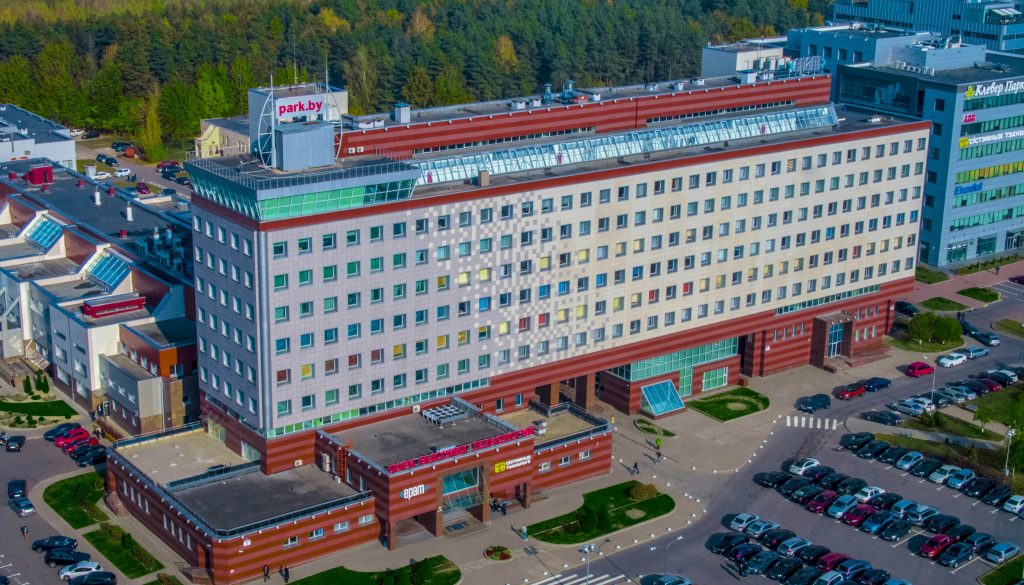



From Soviet investments in the electronics industry to modern tech giants – the conditions behind the development and success of Belarusian IT.
The roots of Belarus’s IT sector and its eventual success trace back to the Soviet era, during the reconstruction of the region from wartime devastation. Each Soviet republic was assigned specific functions within the centrally planned economy. The Belarusian SSR, due to its strategic position between Central Europe and the broader Soviet space, was developed as a logistical hub. Minsk, the republic’s capital, became a key site for the electronics, machinery, and precision industries, responsible for final-stage manufacturing. Advanced optical, laser, radio, and computing equipment was designed and built there.
The Belarusian SSR was home to the production of Minsk-brand computers, a flagship Soviet computing initiative of the 1960s developed without reference to Western designs. Thousands of units were produced annually—an impressive output by Soviet standards. These machines were deployed across scientific institutions, industry, and the military. In later years, the Minsk series was phased out in favor of the ES EVM (Unified System of Electronic Computing Machines), a Comecon-wide project modeled on IBM systems. This new line was also partially manufactured in the Belarusian SSR and other Soviet republics.

The Belarusian SSR, serving at the time as an assembly hall of the Soviet economy, also played a critical role in research and the training of technical personnel. The USSR maintained a strong engineering culture—scientific olympiads were common in secondary and higher education, and technical professions provided relative stability and social prestige. A high standard of education in science, technology, and engineering was maintained by local Minsk universities: Belarusian State University, the Minsk Radioengineering Institute, and the Belarusian State University of Informatics and Radioelectronics—all of which remain active today.
After the USSR collapsed, professors and graduates from these institutions laid the foundations of today’s Minsk-based tech giants—often working out of university labs, garages, or Khrushchyovka flats.
After the collapse of the Soviet Union, Belarus—like the rest of the post-Soviet space—entered a period of political and economic instability. The transition from a planned economy to a capitalist one was difficult and ambiguous. The disintegration severed economic ties between former union republics and the broader Eastern Bloc. Unemployment and inflation surged, leading to widespread impoverishment and a rise in crime. Only with the fall of the communist system did true private enterprise become possible. In contrast, some private activity had been more tolerated in Poland under the PRL than in the Soviet Union, where for decades everything had been fully state-owned.
Elected in 1994, Alexander Lukashenko stalled the trajectory of economic transformation by halting the privatization of state enterprises and maintaining a dominant role for the state in the economy, leaving the private sector marginal. This stands in direct contrast to Poland, where the private sector now dominates, and state control is mostly limited to strategic enterprises. Despite the hostile environment, the first Belarusian tech ventures emerged in the shadow of the state economy—many of which still operate today and have achieved international success.
The founders and staff of these companies typically came from local research institutes and former state enterprises. The first recognized private tech company in Belarus was Dainova, founded in 1991 by Adam Plyukhanovich, which produced computers under its own brand. In 1994, Belhard was established—a holding company active across hardware, software, media, and education. It became Belarus’s first IT incubator, spawning a generation of tech firms. In the banking sector, companies such as Belsoft, BelAVM, and Belvaleks emerged, initially focusing on banking software before aiding in the digitization of state institutions and enterprises. Eventually, they expanded to other post-Soviet markets, including the Caucasus, Central Asia, and Russia.
The early Belarusian IT sector centered on hardware, outsourcing services, and banking software. Low labor costs combined with high technical skill levels gave local firms a competitive edge, attracting partners from the US, UK, Germany, and Russia. Notably, Polish firm NTT System, led by Tadeusz Kurek, invested in computer production in Belarus and operated in the local market until 2010.
Among the companies founded in the 1990s, several stand out for having moved their headquarters abroad while maintaining development centers in Belarus. These firms now play a significant role in the global tech market.

At the turn of the millennium, despite the authoritarian nature of the regime, Belarus entered a phase of relative stabilization that stood in stark contrast to the chaos of the 1990s. This brought a more predictable environment for local tech entrepreneurs and foreign firms looking to cooperate. In the first decade of the 21st century, the Belarusian IT phenomenon began to take shape, gradually evolving into a strategic sector of increasing international relevance. The industry underwent a process of institutionalization and professionalization, with Belarusian companies expanding more confidently into foreign markets.
In 2001, by presidential decree, the organization Infopark was established under the Belarusian State University. It gathered Belarusian IT firms and aimed to support the sector by shielding local software producers, countering monopolies, and offering preferential tax incentives.
The real turning point came in 2005, driven by Valery Tsepkalo, former diplomat and presidential advisor on science and technology. That year, a presidential decree launched the High Technologies Park (HTP), intended as Belarus’s answer to Silicon Valley. While HTP had a physical campus, its privileges—such as exemptions from income and VAT taxes, a reduced personal income tax rate (9%) for employees, and customs relief for computer equipment—applied regardless of a firm’s physical location in the country. In 2011, the number of HTP residents surpassed 100; by 2016, it exceeded 180; after 2020, more than 400.
Interest in the IT sector surged. The country saw the emergence of industry conferences, coding bootcamps, and specialized university programs. HTP policies helped stem the brain drain of local developers and attracted foreign investors to the Belarusian tech ecosystem.

During this period, Belarusian-Russian technological cooperation intensified, particularly under the framework of the Union State of Belarus and Russia (USBR). The first phase of the SKIF project was launched, involving a series of high-performance supercomputers developed by Belarusian research institutes in collaboration with the Russian Academy of Sciences. Beyond state-level initiatives, favorable tax policies attracted both small and large Russian firms, including a subsidiary of Sberbank Technologies and Yandex, Russia’s equivalent of Google.
At the same time, Western firms began entering the Belarusian market. Finnish outsourcing company Tieto opened an office; development centers were launched by the Danish-Ukrainian Ciklum and Polish Ericpol. German heavyweight SAP also established operations, servicing key Belarusian state-owned enterprises and administrative institutions.
Belarus became one of the first countries globally to introduce comprehensive cryptocurrency regulation. In 2017, the president signed a decree legalizing crypto-related activities and exempting individuals and companies from related taxes. Eligibility for these privileges required IT Park residency status, which subjected firms to oversight and compliance with anti–money laundering and anti–terrorism financing regulations.
Beyond attracting investors, Belarus also began exporting its own products. Around this time, Belarusian tech startups started emerging, several of which would go on to achieve international success in the following years.

At the start of the new decade, the Belarusian IT sector experienced two major shocks. The first occurred in 2020, following mass social protests after the presidential elections. The second came in 2022, after the outbreak of the Russian-Ukrainian armed conflict, during which Belarusian territory was used for military operations. As a result, international sanctions were imposed on the country, significantly increasing uncertainty in the business environment. The restrictions included bans on cooperation with selected Belarusian companies, cutting banks off from Western financial systems, and export bans on certain technologies. Fearing legal risks and reputational damage, many foreign clients withdrew from working with companies operating in Belarus. Following these events, some Belarusian IT firms deliberately began omitting information about their origin to avoid negative associations in the eyes of international clients.
In response, numerous companies from the IT sector decided to relocate — most often to neighboring countries such as Lithuania or Poland, but also to Georgia, Armenia, or Uzbekistan. According to estimates by the dev.by portal, between 2020 and 2024, between 16,000 and 22,000 IT specialists left Belarus. Due to the migration of Belarusian professionals, the Polish government launched the Poland Business Harbour initiative in early 2020 to support their relocation to Poland by offering legal and visa assistance. Poland became the first choice of destination for about two-thirds of Belarusian IT specialists.
According to official data from the Belarusian High Technology Park (HTP), it now hosts over 1,000 resident companies, 35% of which are foreign entities. More than 100 of these companies are located outside of Minsk, in other regions of Belarus. Despite difficulties arising from the challenging international situation, Belarusian firms continue to cooperate with foreign clients. At the same time, there has been a partial reorientation toward the Russian market, which has faced a significant shortage of IT specialists. In 2024, HTP's export revenue reached $1.8 billion (with a record $3.2 billion in 2023), contributing to 2% of Belarus’s GDP.
In recent years, Belarus has made significant advances in artificial intelligence (AI), which is already being actively used in mechanical engineering, banking, and precision agriculture. According to the United Nations Development Programme (UNDP), the country’s strengths include a modern telecommunications infrastructure—featuring high-speed internet and a developing 5G network—as well as widespread access to online services such as e-government and educational platforms.
In 2025, in cooperation with Chinese partners, a development center was opened at the Belarusian Academy of Sciences to support research and implementation of AI solutions, with particular emphasis on natural language processing and analytical systems. This partnership aims to increase Belarus’s competitiveness in the global technology market. Additionally, a joint Belarusian-Russian AI development strategy is being developed within the framework of the Union State.
SOURCES: